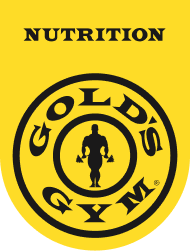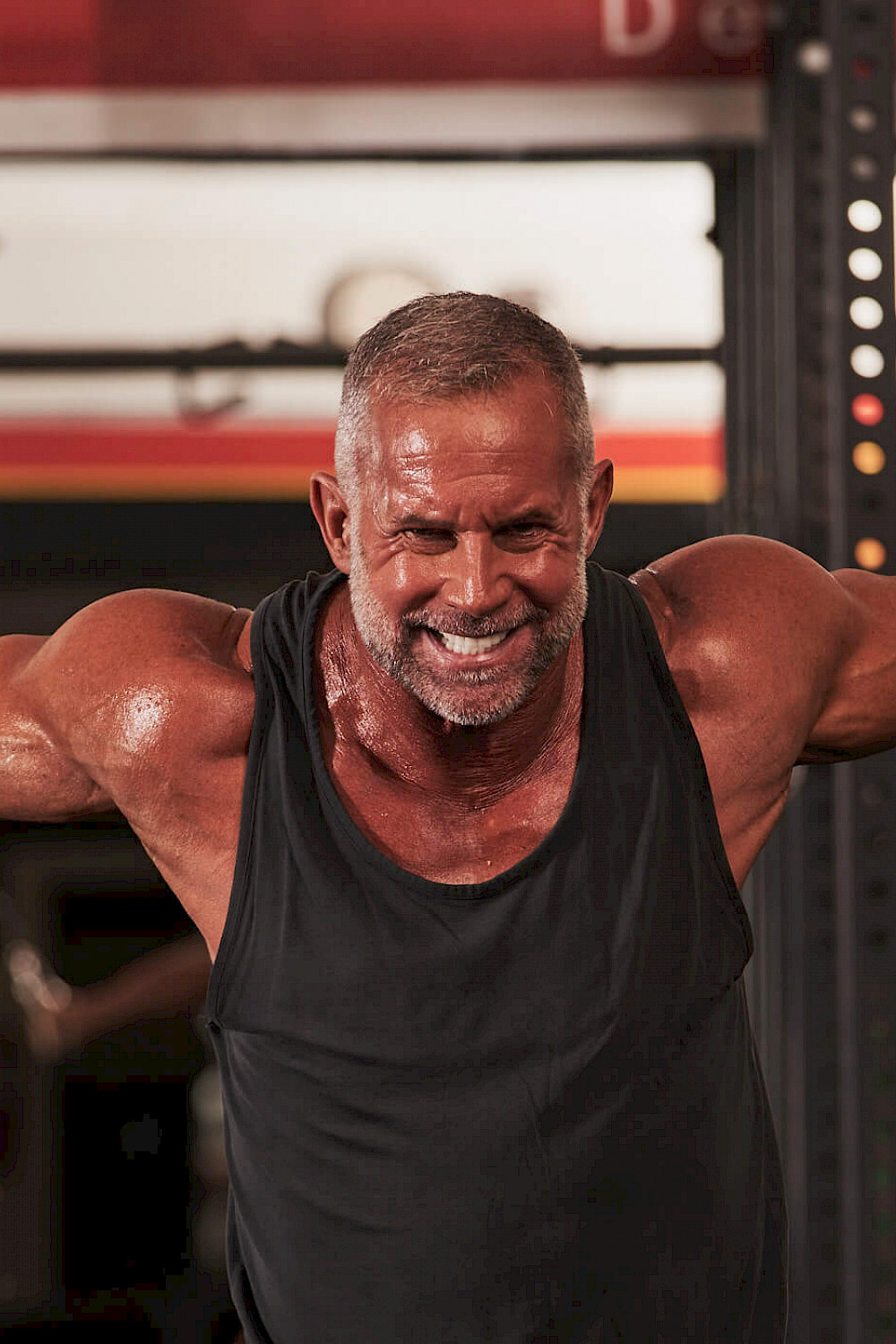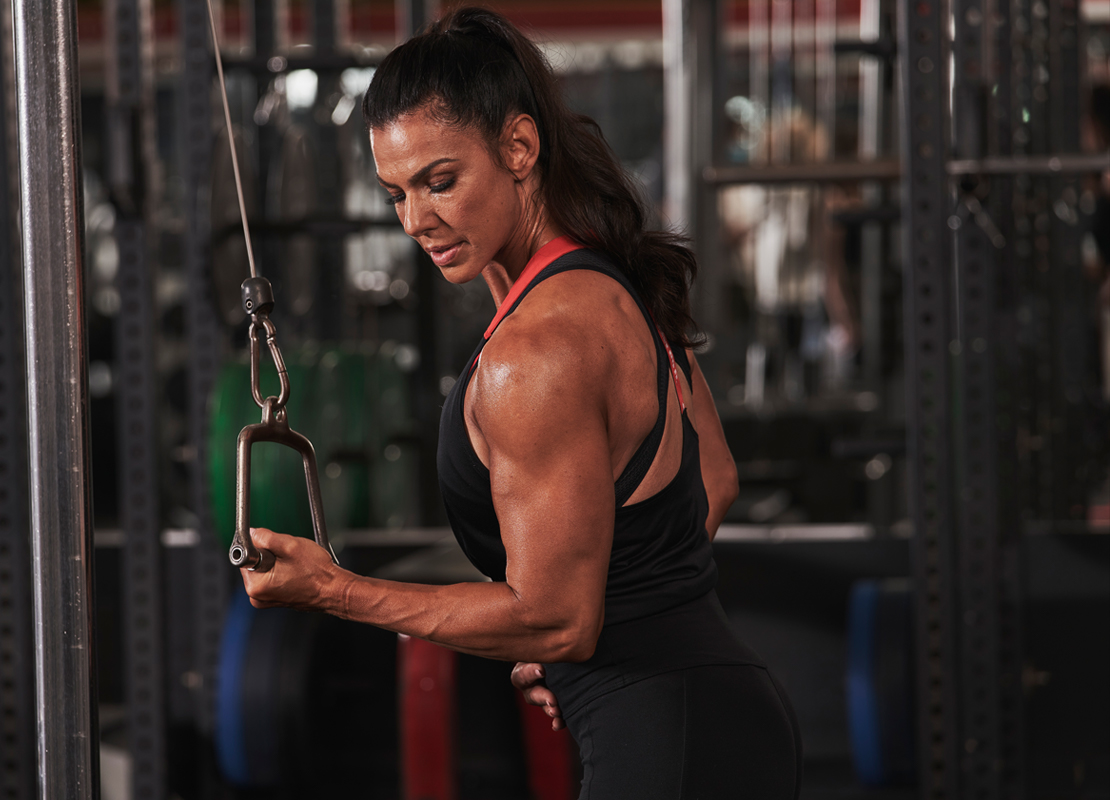GETTING SHREDDED!
A 7-minute read
Cutting body fat to a minimum while building maximum muscle: the dream of a shredded body has long since spread from professional bodybuilders to amateur athletes. After months of gains earned through strict discipline, you want to show people what you’ve got. In this article, we’ll tell you how you can draw attention to your muscles, make your veins more prominent and achieve the definition you crave. After all, it’s no more than you deserve!
3 GOLDEN RULES FOR SUCCESS
If you want to show off your hard-earned successes – and you’ve certainly earned them – you need to follow three crucial rules:
1. Never stop building muscle.
2. At the very least, maintain your muscle mass and counteract catabolic factors.
3. Reduce your body fat percentage.
If you want to see defined muscles when you look in the mirror, you need to follow the right training plan and, above all, concentrate even more closely on getting your nutrition right. This means that, from now on, you can’t skip a single training session or let your nutrition slip. We know just how hard it can be. So, we’ll point out a few things you absolutely must focus on.
Takeaway 1: The perfect combination of nutrition and training is the key to achieving your peak physique.
CALORIC BALANCE: THE GET TO GETTING RIPPED
Shredded, ripped, lean – call it what you want, the key to reaching your physical peak is all about uncompromising definition. The only way to achieve this is by looking at your caloric balance. This determines just how prominent your muscles are. Only with a negative caloric balance (achieved through a moderate caloric deficit) will your body use up its long-term reserves. In short, this means breaking down troublesome fat tissue that has been hiding your muscles. By achieving a negative balance, you’ll reduce your body fat percentage and, ultimately, make your muscles and veins more prominent.
Before you can identify your ideal calorie intake, you need to work out your daily calorie consumption. This consumption figure will tell you how many calories you can consume without gaining or losing weight and is always individual.
It is now also possible to directly calculate your daily calorie requirements to achieve a specific goal. The calorie calculation takes into account your goal, how often you train and your daily exercise levels. If you want to get shredded and defined, then fat burning and weight loss is your goal. If you don’t know your calorie requirements, you can calculate it in just a few seconds with our Calorie Calculator.
But how can you achieve a negative caloric balance in practice? Well, you have two options:
1. Boost your calorie consumption so that it's higher than your calorie intake. This means nothing other than burning off more calories through training, exercise and general physical activity than you consume in food and drink.
Or, alternatively:
2. Reduce your calorie intake so that it’s lower than your calorie consumption. This means eating fewer calories than you burn on an average day.>
However, launching into a poorly thought-through calorie-reduced diet that will only leave you hungry is not the right path. Instead, we recommend implementing a moderate blend of both options. Get rid of any thoughts of a crash diet! You shouldn’t exceed a caloric deficit of 300-500 kilocalories by making changes to your diet. That said, if you follow the tips below, you should still get a lean, ripped body – quickly, but in a controlled process.
Takeaway 2: A negative energy balance is essential to reduce your body fat percentage and thus add muscle definition.
✓ Will you still achieve a moderate caloric deficit with your current training schedule?
✓ Are your training sessions feeling easier than they did a few weeks ago?
✓ Is your training plan still aligned with your goals?
If you’re disciplined in pursuit of your goals, you’ll reach them. Definition and shredded muscles are a question of stamina, willpower and the right plan. It’s vital that your training doesn’t stagnate. Find new incentives and up the intensity of your workout sessions. Your body needs new challenges! Doing reps all the way to muscle failure? Show your body that you’ll push it all the way in the definition phase!
By the way: Focus on antagonistic supersets. This will allow you to train opposing muscle groups one after the other without the need for a break. For example, you might do a set targeting your triceps and follow it up by working your biceps. Not only is this ultra-effective, it also saves time. It allows you to give one muscle region a rest (in this case, the triceps) while you focus on its counterpart (biceps).
Takeaway 3: Challenging strength training should still be part of your weekly training plan.
2. CARDIO, CARDIO, CARDIO
Tedious but beneficial: from now on, integrate some endurance sports into your routine to get your body’s fat-burning processes up and running. Whether jogging, swimming or cycling, the main thing is that you see it through! So, get exercising outside a couple more times a week, or spend some time in your favourite gym’s cardio area. Work up a sweat – you’ll soon see the benefits! That said, make sure not to overexert yourself. Incorporate the cardio sessions in moderation, based around your strength training. Too much exertion and too little rest will get you nowhere.
By the way: high-intensity interval training (HIIT) is perfect, time-saving cardio training. It’s made up of short – but very intense – training intervals with short recovery periods. It gets your pulse up, kick-starts your body’s circulation and also generates the beneficial afterburn effect.
Takeaway 4: You can’t get away with skipping cardio units any more. Sorry!
3. FIRST THINGS FIRST: PROTEIN!
Let’s get one thing clear: you can’t achieve a calorie deficit at the cost of getting a good supply of protein. Your muscles are always working and need their nutrients. Muscle is far more active than sluggish fatty tissue and is your most valuable fat burner. For this reason, you need to pay special attention to building and maintaining muscle. The more of your body is made up of muscle mass, the higher your basal metabolic rate (BMR) will be. Only by tailoring your diet and giving your muscles a suitable supply of protein will the results of your efforts yield a rock-hard body. This is because as well as promoting muscle growth, proteins also promote muscle retention. A further benefit is that they keep us feeling full!
In practice, this means:
✓ Eat 1.8 – 2.3g protein/pro kg you weigh/day
✓ Low-fat, high-protein foods
✓ Protein balanced with varied, low-calorie vegetables
There are times when it isn’t easy to eat such large amounts of protein. Gold’s Gym Nutrition has the ideal solution for precisely this scenario. Whether bars, shakes or drinks, our products can help you to meet your new nutritional requirements. Zero regret and zero time wasted – so there’s no excuses any more!
Takeaway 5: Increase your protein intake by turning to low-fat protein sources and high-protein fitness food in addition to your workout routine.
4. A BLESSING AND A CURSE: CARBS
While you’re upping your protein intake, it’s only logical that you should make savings elsewhere – you need to achieve a caloric deficit, after all. Reducing your carbohydrate intake would be the best option.
However, despite reducing your intake, carbs still have an important place in your nutrition plan. “No carb” diets are pretty certain to lead to a caloric deficit, but your ability to perform mentally and physically will suffer just as fast. Carbohydrates fuel our workouts, so you shouldn’t remove them from your diet entirely. However, products made with white flour or refined sugar are like poison. If you want to reduce your body fat and get shredded muscles, these are the products standing in your way. Instead, you should look for wholemeal bread, potatoes, oats or brown rice. These provide you with energy over a longer period and keep you feeling full for longer. Your body needs high-quality nutrients, particularly after an intensive training session, in order to protect against muscle depletion and compensate for nutrient deficits. Carbs are a key part of this.
In practice, this means:
✓ Reduce your carb intake.
✓ Eat wholemeal products.
✓ Don’t reduce your daily carb intake below 1g per kilo you weigh.
✓ You absolutely can and should eat carbs after a workout.
Takeaway 6: While you need to reduce your carb intake, you shouldn’t kick potatoes off your shredding diet completely!
5. BETTER THAN THEIR BAD REP: FATS
Now, let’s take a look at the last of the major nutrients: fat. For a long time, it was simply seen as the enemy in the fight to keep off the kilos. However, if you want to reduce your body fat percentage and get defined muscles, what fats you choose matters much more than simply how much fat you eat! Avoid products with trans fatty acids and use vegetable oils with lots of unsaturated fatty acids. These are essential for your hormone balance and building muscle – and not forgetting for your testosterone level, which is the Number 1 anabolic hormone! So, just like for carbs, what matters is quality over quantity!
In practice, this means:
✓ Fried products like chips and fatty baked goods are a no-go.
✓ Use vegetable oils made from rapeseed, coconut, linseed, nuts or olives.
✓ Avocados and fat-rich fish varieties like cod and salmon are ideal.
Takeaway 7: When it comes to fat, focus on quality not quantity! Opt for unsaturated fatty acids found in vegetable oils and fat-rich fish.
6. LOTS OF WATER & VEGETABLES
You’ll certainly have heard of bodybuilders drinking litres of water before a competition. But, if you’re not competing on stage, you don’t need to go to such extremes – and nor should you. That being said, water has a lot of benefits. Not only does it help to flush out waste, it also removes excess water retention from your body and frees up your muscles. It enables you to perform and plays a role in just about every key metabolic process in your body. So, try to drink more water than you usually do.
You should also avoid having too much salt in your food, as salt binds water in the body. If you want to avoid a slightly squishy look that water retention can sometimes cause, avoid salt for a while and use chilli and herbs to season your food instead.
Now let’s turn our attention to fruit and vegetables. In terms of quantity, fruit and vegetables sit alongside protein as the foundation of your future nutrition plan. Why? Well, thanks to their often low calorie content, the provide countless vitamins, minerals and fibre. And they are an absolute must-have. Save for a few exceptions, you can eat as many vegetables as often as you like! They will fill your stomach without providing vast quantities of energy, helping to pave the way to a negative caloric balance!
Takeaway 8: Fruit and vegetables sit alongside protein-rich products as your main sources of nutrition; however, it is crucial that you cut your salt intake.
TAKE-HOME MESSAGE: SHREDDING TAKES TIME AND DEDICATION
- Focus on strength and interval training.
- A negative energy balance is essential.
- Keep building muscle, give yourself new training incentives and incorporate cardio sessions in your new workout plan.
- Boost your protein intake and cut down on carbs.
- Use oils and fats with unsaturated fatty acids and drink plenty of water.
- Fruit, vegetables and high-protein foods should be the foundation of your diet.Patience, willpower and a disciplined plan – it’s a winning combination!



